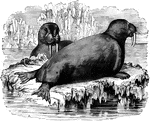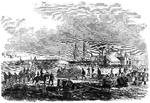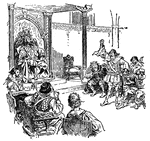
Old English Hound
"The old englsih hound is supposed to be the original stock of the island of Great Britain, and was…

Lieutenant Colonel Morrison
"Heroic conduct of Lieutenant Colonel Morrison, Seventy-Ninth New York Highlanders, on the parapet of…

Edward's Ferry
"Successful retreat of the Federal troops from the Virginia shore across a canal-boat bridge at Edward's…
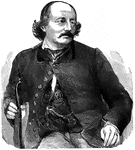
General Benjamin F. Butler
"General Butler was born in Deerfield, N. H., November 6th, 1818. At the time of President Lincoln's…

Battle of Secessionville
"Battle of Secessionville, James Island, S. C.- bayonet charge of Federal troops, commanded by General…

James Island
"Repulse of the Confederates at James Island, near Charleston, S. C., June 10th, 1862, in the attempt…
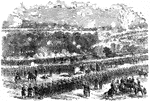
Battle of Malvern Hill
"Battle of Malvern Hill, near Turkey Bend, James River, Va., fought Tuesday, July 1st, 1862. The battle…

Destruction of Merrimac
"Destruction of the Confederate ironclad steamer Merrimac, blown up by its commander, on the…
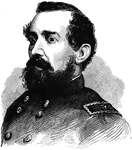
General Jesse L. Reno
"General Reno, born in Wheeling, W. Va., June 20th, 1823, died on South Mountain, Md., September 14th,…

Shelling of Confederate Camp
"Shelling of a Confederate camp on the Potomac by Lieutenant Tompkins, of the First Rhode Island battery.…

State Prisoners at Fort Lafayette
"Landing state prisoners at Fort Lafayette, New York harbor, in 1861. Fort Lafayette, New York harbor,…

Ship Island
"Ship Island, near the mouth of the Mississippi- United States war steamer "Mississippi" firing on a…
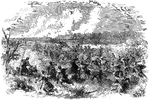
Battle of Roanoke Island
"Battle of Roanoke Island, February 8th, 1862- decisive bayonet charge of the Ninth New York Volunteers…
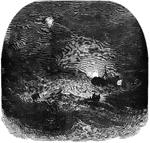
Monitor
"Loss of the Monitor- gallant attempt of the officers and crew of the United States steamer…

Camp Wool
"Camp Wool, two miles from Fort Clark, Hatteras Island, occupied by Hawkins's Zouaves, Ninth Regiment,…

Conrad's Ferry
"Conrad's Ferry, Md., above Harrison's Island, on the Potomac River, the place of passage of Colonel…
Confederates
"Confederates in ambush firing on a reconnoitring expedition to Oyster Creek, Roanoke Island, N.C."—…

General John G. Foster
"General Foster, born in Whitefield, N. H., May 27th, 1823, died in Nashua, H. H., September 2nd, 1874,…
Fort Clinch
"Exterior view of Fort Clinch, on Amelia Island, Fla., commanding the Harbor of Fernandina, captured…
Fort Clinch
"Interior view of Fort Clinch, on Amelia Island, Fla., commanding the Harbor of Fernandina, captured…

Common Seal
"The ground-color of the hair or skin, when this animal is alive and dry, is pale whitish-gray, with…
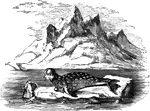
Hooded Seal
"Also called the Crested Seal, remarkable for possessing, about two inches from te extremity of the…

Sea Bear
"It is the size of a large bear; girth at the sholder, five feet, near the tail, twenty inches; fur…
Charleston Harbor
"The harbor of Charleston, S. C.- Fort Moultrie, on Sullivan's Island."— Frank Leslie, 1896

Edward's Ferry
"Edward's Ferry, Md., below Harrison's Island, on the Potomac River, the place of the passage of General…

Shannon
"Firing on the schooner Shannon, laden with ice, from the battery on Morris Island, Charleston…

Tybee Island
"Tybee Island, Savannah River, Ga.- Views of the lighthouse and barracks- destruction of the lighthouse…

Mortar Battery Stanton
"Interior of the Mortar Battery Stanton, Tybee Island, Ga., showing the operation of 13-inch mortars…
General Hospital Exterior
"United States General Hospital, Hilton Head, S. C., exterior. The United States General Hospital at…

General Hospital Interior
"United States General Hospital, Hilton Head, S. C., interior. The United States General Hospital at…
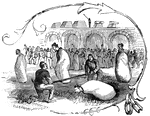
Hurdle Sack Race
"Federal soldiers participating in a hurdle sack race. Thanksgiving festivities at Fort Pulaski, Ga.,…
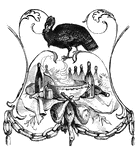
Thanksgiving Dinner
"Thanksgiving dinner. Thanksgiving festivities at Fort Pulaski, Ga., Thursday, November 27th, 1862.…
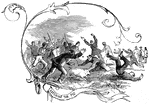
Catching the Pig
"Soldiers playing 'catch the pig.' Thanksgiving festivities at Fort Pulaski, Ga., Thursday, November…

Burlesque Dress Parade
"Soldiers participating in a burlesque dress parade. Thanksgiving festivities at Fort Pulaski, Ga.,…

Thanksgiving Ball
"Soldiers and women participating in a Thanksgiving Ball. Thanksgiving festivities at Fort Pulaski,…

Wheelbarrow Race
"Soldiers aparticipating in a wheelbarrow race. Thanksgiving festivities at Fort Pulaski, Ga., Thursday,…
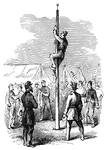
Climbing Pole
"Soldiers climbing up a greased pole. Thanksgiving festivities at Fort Pulaski, Ga., Thursday, November…
Fort Taylor
"Fort Taylor, Key West, Fla. Key West, the most western of the Pine Islands, is about sixty miles southwest…

Banks Expedition
"The Banks Expedition- scene on the hurricane deck of the United States transport North Star-…

Kentucky Shore
"The Federal Army, under General Pope, landing on the Kentucky Shore, opposite New Madrid, April 1st,…
Fort Vulcan
"Fort Vulcan, Jones's Island, Savannah River, Ga.- one of the Federal batteries cutting off communication…

General John Pope
"General Pope, born in Louisville, Ky., March 16th, 1822, was graduated from the United States Military…

Bogue Island
"The Federal siege works on Bogue Island, N. C., erected for the reduction of Fort Macon. Our sketch…
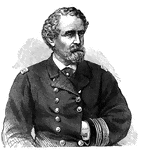
Rear Admiral James Alden
"Rear Admiral Alden, born in Portland, Me., March 31st, 1810, died in San Francisco, Cal., February…

Advance upon Charleston
"The advance upon Charleston, S. C.- pioneer movement- landing of the One Hundredth New York Volunteers…

Fort Walker
"View from the interior of Fort Walker, Hilton Head, S. C. looking inland, showing the defenses from…

Che-Kiang
"The Banks Expedition- a Confederate Schooner running into the United States transport Che-Kiang,…
Fort Moultrie
"Siege of Charleston, S. C. Bombardment of Fort Moultrie and Batteries Bee and Beauregard by the monitors…
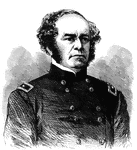
General Henry W. Benham
"General Benham, born in Connecticut in 1817, died in New York June 1st, 1884, was graduated from the…
!["Presentation of colors to the Twentieth United States [African American] Infantry, Colonel Bartram, at the Union League Clubhouse, New York, March 5th, 1864. The Twentieth Regiment, United States [African American] Troops, left Riker's Island at nine o'clock on the 5th of March, 1864, on board the steamer <em>John Romer</em>, and were conveyed to the foot of Twenty-first Street, East River, New York, where they were disembarked and formed in regimental line, and marched to Union Square, arriving in front of the Union League Clubhouse at one o'clock. A vast crowd of citizens, of every shade of color and every phase of social and political life, filled the square and streets, and every door, window, veranda, tree and housetop that commanded a view of the scene was peopled with spectators. Over the entrance of the clubhouse was a large platform, ornamented with flags and filled with ladies. In the street was another platform, tastefully decorated and occupied by prominent citizens. From the stand the colors were presented by President King of Columbia College, who addressed them with warmth and eloquence. After the presentation ceremony was over the men stacked arms and partook of a collation provided for them."— Frank Leslie, 1896](https://etc.usf.edu/clipart/11700/11749/presentcolor_11749_mth.gif)
Presentation of Colors
"Presentation of colors to the Twentieth United States [African American] Infantry, Colonel Bartram,…

Howlett's Battery
"Howlett's Confederate Battery on the James River, Va., shelling the Federal monitors and laborers on…

Belle Isle
"View of Richmond, Va., from the prison camp at Belle Isle, James River. Belle Island is situated in…
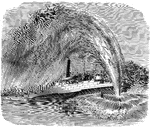
Commodore Barney
"The war in Virginia. Explosion of a torpedo under the Commodore Barney, on James River, August…

Charleston
"Seacoast operations against Charleston- brilliant dash and capture of Confederate rifle pits and prisoners…
